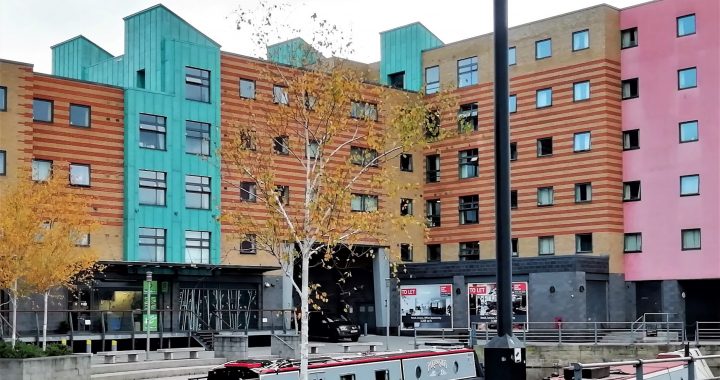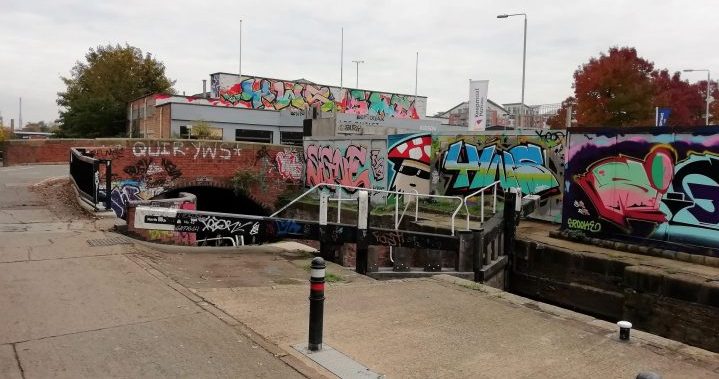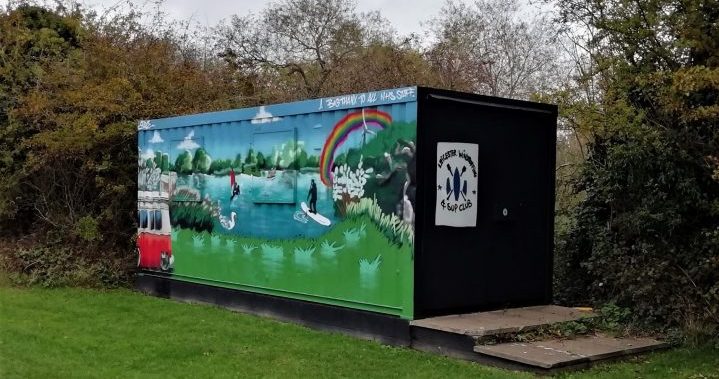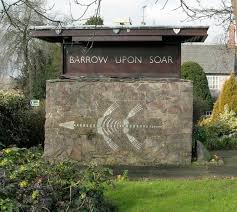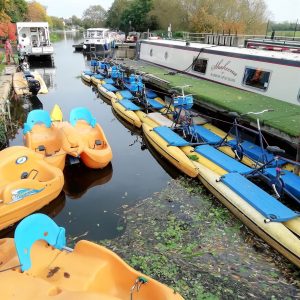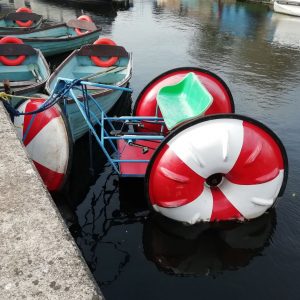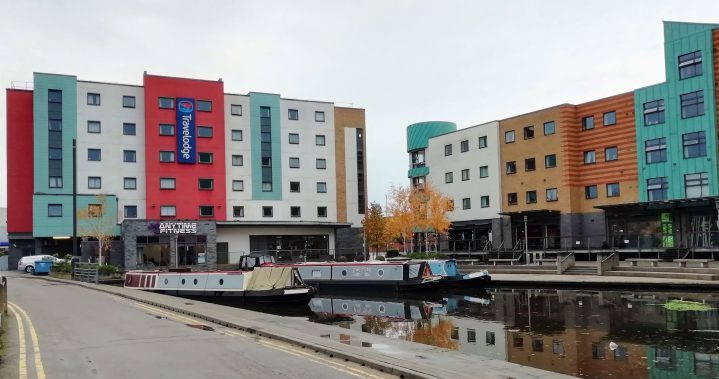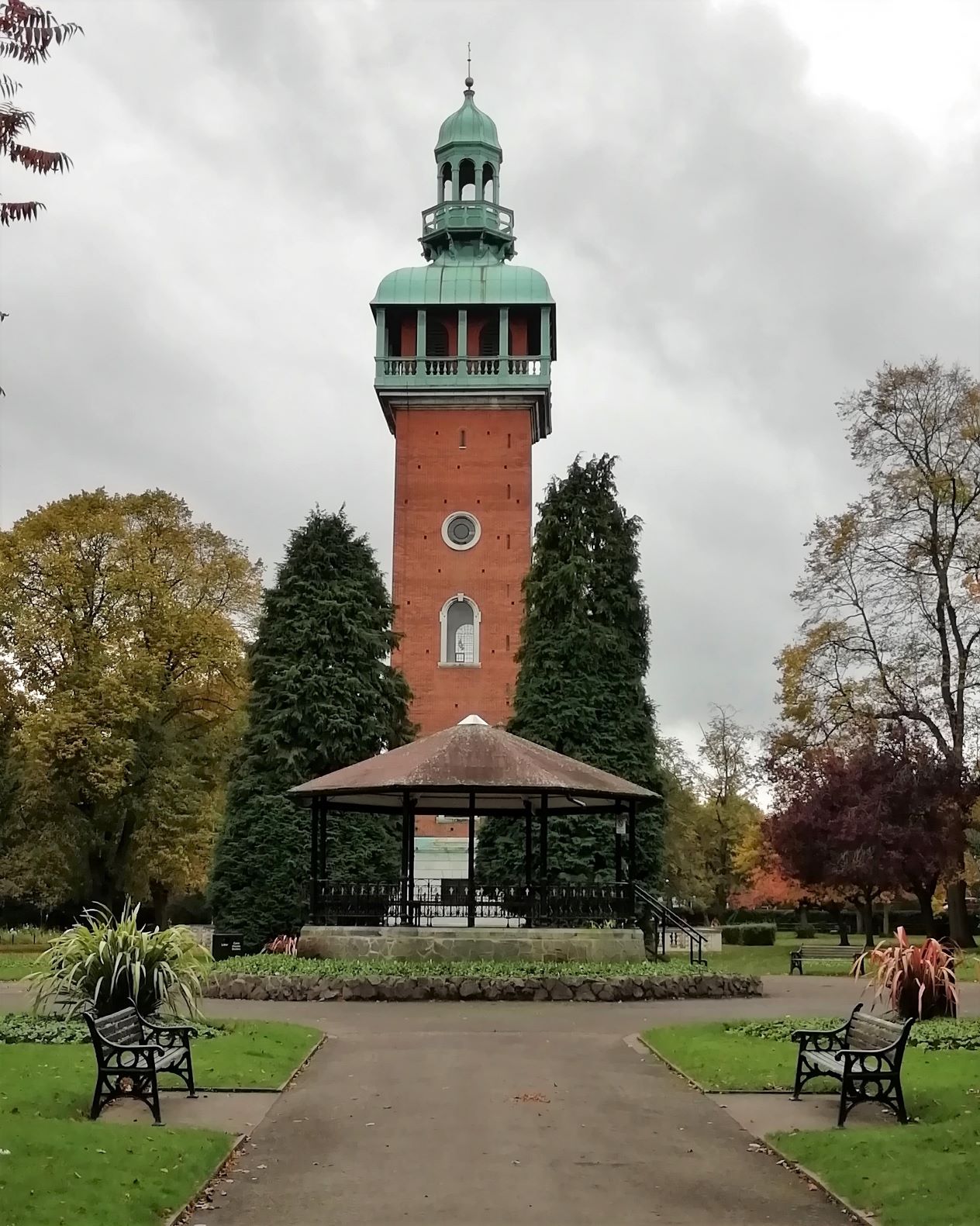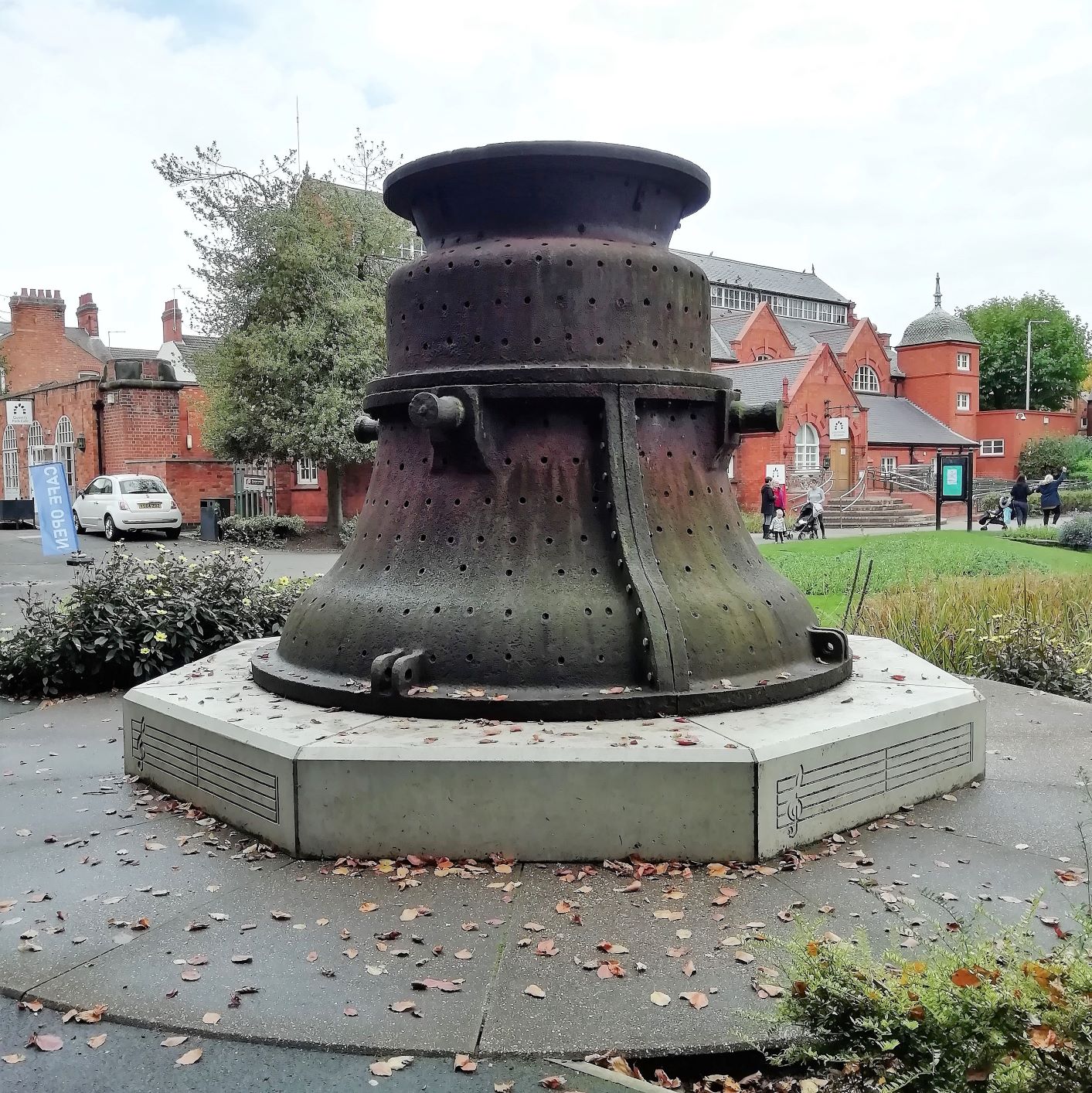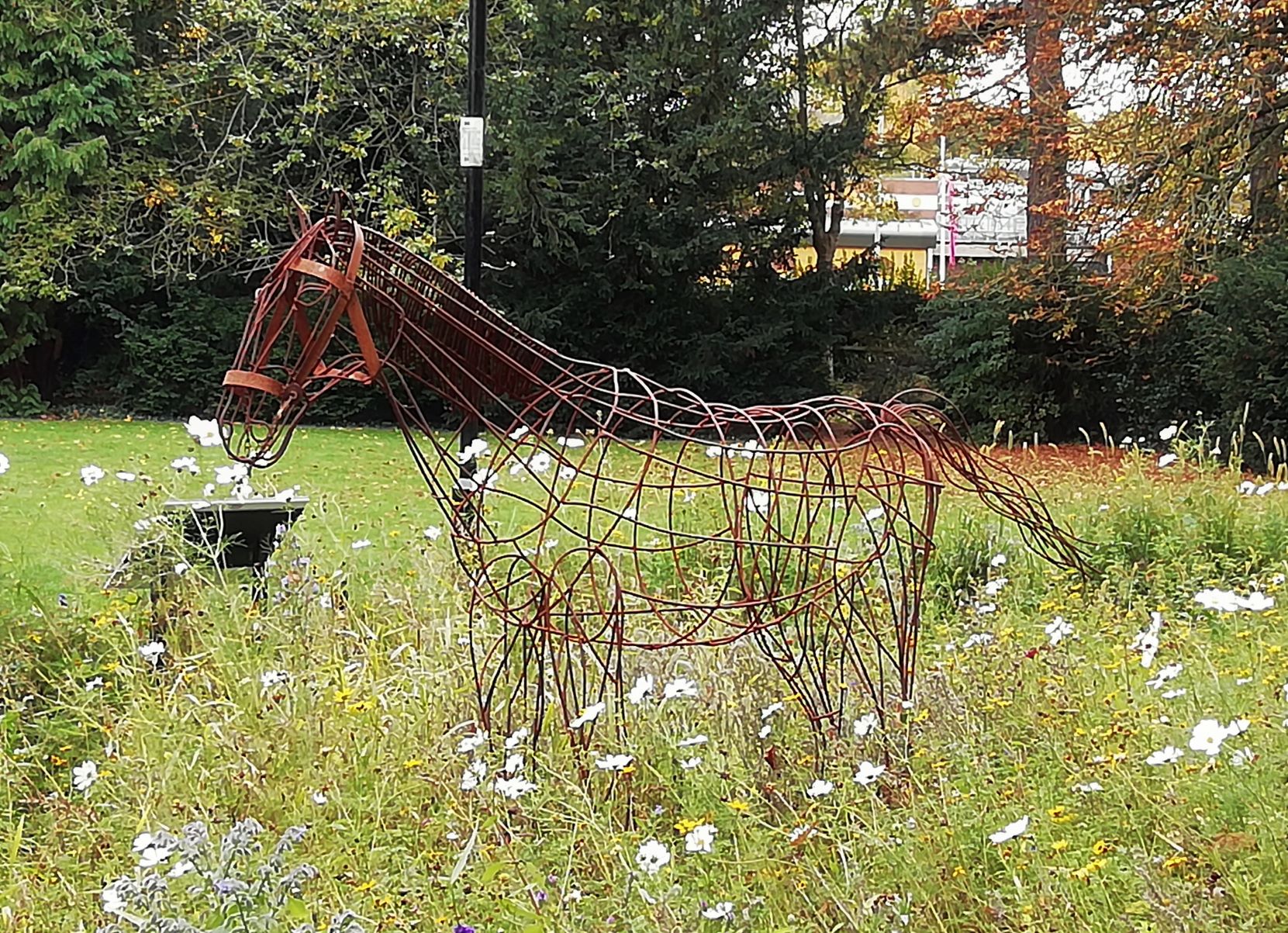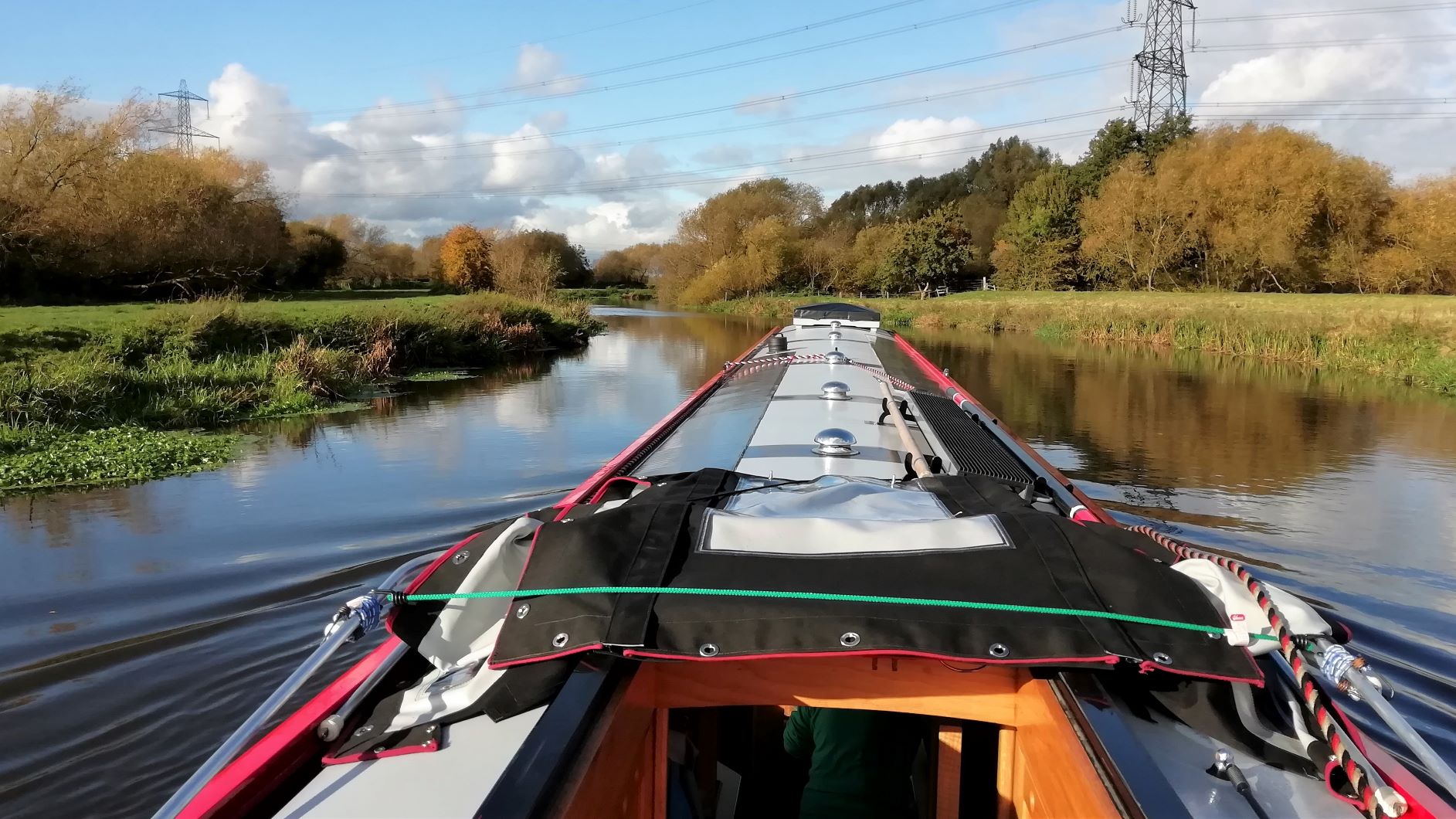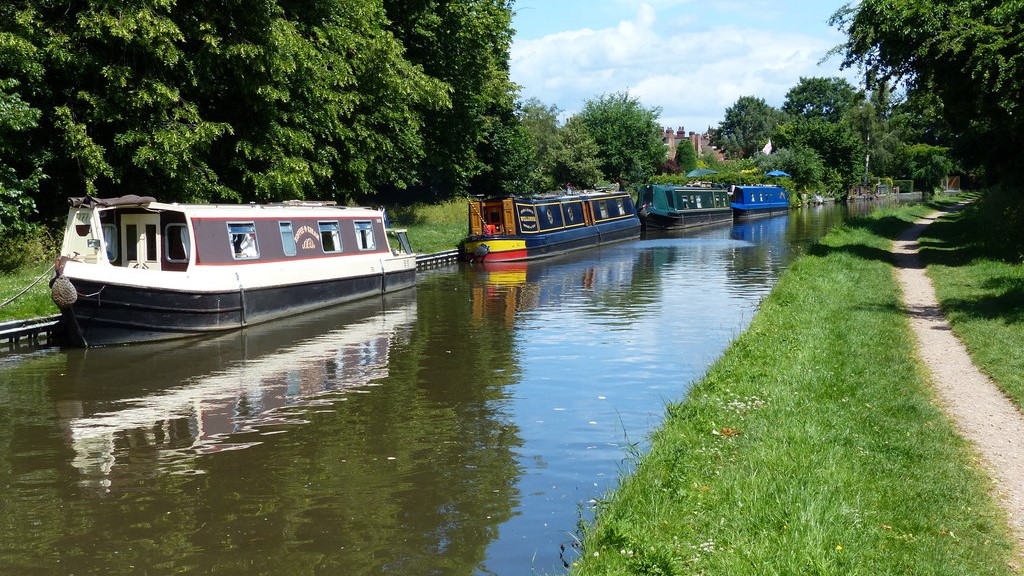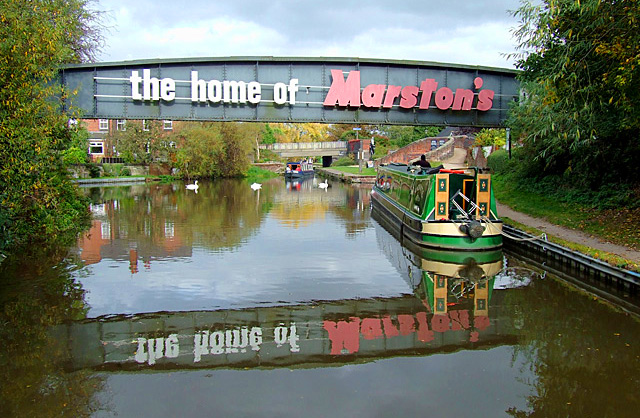Leicester's Local Lockdown
Leicester is quite extensive, although it doesn't feel that oppressive from the water. As you move through it you are, in principle, shifting from river to canal and back again but in practice it all looks like one watercourse. It is pretty wide and heavily used by boat clubs and paddle boarders. We had single oarsmen as well as pairs and fours (coxless or otherwise) rushing up and down outside the boat from quite early on Sunday morning until we left, approaching noon. It was quite like the Thames in that respect. At the locks, however, there are clear reminders that you are in a big city with the usual urban mess.
Given that Leicester was now in tier two restrictions, with most of its visitor attractions closed, this didn't seem like the right time to be sticking around for a couple of days and exploring the city, we will have to come back another time. As well as the great unpleasantness we wanted to move on through the sections of the River Soar and back onto the managed canal while we appeared to have a spell of fairly calm weather ahead. Heavy rain often leads to closure notices for the River Soar and Trent Junction. Some appointments had also been made during early November for which we needed to be back at the house. Up to now we hadn't had a plan but now we needed to make one. It turned out that there wasn't that much slack in it and it didn't leave too much time for sitting still and exploring.
Having said that, since we were in a city, we fancied an urban treat. An occasional guilty pleasure is a 'dirty burger' - a quarter pounder with cheese, smothered in burger sauce, on slightly brown lettuce and accompanied by a portion of fries. They are served in the cheapest kebab shops up and down the land. Mask in hand I slipped out under cover of darkness in search of the part of town where one could be sure to find the garish neon signage of fast food joints jostling along the high street, all running on idle as they waited for the late night pub trade to stagger forth. I had to negotiate the locked gate to the pontoon, navigate my way through Castle Gardens in the dark to find the only gate a CRT key would open and then work out how to unlock it. It took longer to do that than to find my goal. All I had to do was follow the steady stream of students flowing down the hill and there, just across the bridge and round the corner, was the pub quarter. In fact, although it was fairly busy, people did, by and large, seem to be trying to follow the rules, wearing face masks and keeping as much distance as they could. I'm pretty sure it was a lot quieter than it would normally be on a Saturday night in term time.
There was a Tesco Superstore just behind the buildings on the opposite side of the canal. A pedestrian bridge, kept locked at night, runs from the gardens just behind the mooring straight across the canal towards the supermarket. On Sunday morning as soon as they opened, Sue set off to replenish our supplies while I tackled the final bits of post paint-job snagging on the boat.
King Lears Lake
We had identified an area of open land that seemed to be mostly water but with mooring shown north of Leicester, at King Lear's Lake. That seemed like a quiet place to moor up on Sunday night and it was five miles or so further on, with five locks on the way. Another section of river lay just beyond Castle Gardens but that would split off again just at the last bridge before the lake, leaving the navigation to continue as a canal again.
The locks weren't in that great condition. The first one was leaking water in at the top as fast as it could leave at the bottom, which made it particularly hard to open. The next was worse proved extremely hard to open. We were there for ages and in the end filled and emptied the chamber a couple of times to try and get the gates to seal better. Eventually I noticed that the shaft holding one of the top paddles would bend slightly out of alignment when it was wound fully down. Raising it just a few inches so the shaft was straight must have just brought the paddle itself into alignment under the water to improve the seal just enough. An extra inch or so of water makes an awful lot of difference and we were finally able to get the front gate open. The rest were fairly straightforward after that and we even got some help to work one of the locks from one of the locals out kicking their heels on a Sunday afternoon.
We had planned to go into Leicester Marina on the way to use their services. The intention was to top up with diesel at the same time so they would get something out of it. They close at four o'clock on a Sunday and we tied up on their service wharf at three fifty-five so we thought we had made it in time but there was no-one to be seen and no-one answered the phone number that had been left to ring for service. Obviously, they had decided it wasn't worth waiting until the actual closing time but that wasn't that big a surprise. As it happens we could access everything that we needed without having the staff in attendance. We didn't particularly need the diesel so it worked out OK for us, a lost sale for them. We had one more lock after that before King Lear's Lake.
We had expected that we would be moored alongside an expanse of open, waterlogged ground, the remnants of old quarries and industrial workings. In fact, we found that the canal towpath was lined by a tall hedge and behind it King Lear's Lake was a tidy, well maintained public open space with firm path going all the way around the lake and forming part of the overall Watermead Country Park. There is a statue of King Lear on the other side of the lake, which presumably gives it it's name rather than having been placed there because it was King Lear's Lake. However we didn't find any details on this so who knows? It could be a bit chicken and egg. On this side of the lake was a slipway and the modest headquarters of the Leicester Windsurfing And Stand Up Paddle-boarding Club, who had clearly decided the best way to beat the graffiti gangs was to join them, leaving no canvas for them to work with.
The park was very busy on a Sunday teatime with people walking in all directions with their well-behaved dogs and unruly children. It was even pretty busy on a Monday morning. However, the hedge was a really effective separator between the lakeside and the towpath, which was completely deserted. As the evening came it soon emptied out and we had a very pleasant place to stay. The only negative was a very loud banging and crashing noise coming from the retail park that we identified on the map just the other side of the woodland standing on the opposite bank of the canal. We assumed it would stop as the premises there closed down but whatever the operation was it carried on all night. It was a bit distracting at first but soon faded into the background noise in the same way we find the trains and the motorways do when we have to moor nearby.
Barrow Upon Soar
Monday was quite a straight forward leg up to Barrow Upon Soar, six or seven miles and four locks. This time we joined the River Wreake for a spell, just beyond the Country Park, before the River Soar came in and took over again at Cossington. We were aiming for a forty eight hour mooring just by Barrow Boats. This turned out to be a little stretch of mooring just about long enough for one boat between a very fast weir and the boatyard entrance. Luckily, it was empty and we were tied up for a late lunch before going to explore the village.
There is a pub just across from Barrow Boats that looks quite nice but like a lot of places in Barrow it was closed on Mondays. We seem to be making a habit of arriving at places on the days that they are closed. The main part of the town starts just beyond there and it seems quite a nice place. There is a lot of established housing and a small centre down near the river with a few shops and a couple of pubs. The main claim to fame seems to be the "Barrow Kipper", a skeleton of a plesiosaur that was excavated here in the mid 19th century and is celebrated in different ways around the village including a replica of the skeleton gracing a roundabout in the centre.
Walking around the boatyard to get to our boat we could see that there must be a real seaside atmosphere here in the high summer, with all kinds of strange craft available for hire by the hour. In the middle of a COVID October, however, it was rather drab.
Loitering In Loughborough
Leaving Barrow the next morning we caught some sunshine and headed down Deep Lock with a couple on "Tranquility" who are moored locally. There was only one other lock and that was one of the flood locks which are left open when river levels are normal, as they were today. Once past there you are technically back on a canal and it is only a short run to the junction at Loughborough. A left turn here took us up a very short arm to Loughborough basin where a few pontoons are available for public mooring as well as a full set of services. The basin was empty when we arrived and we backed on to one of the very short pontoons by about midday.
Our pram hood fitter and his partner had had their test results back and it had all proved to be a false alarm so he had arranged to come out and meet us here on Wednesday. We planned to have a look around, do some shopping and head off on Thursday morning. It was only on Wednesday night that I noticed that the sign at the entrance said this was a twenty four hour mooring. Fortunately, the facility wasn't under any real pressure. About four o'clock a guy called Alwin, who lived locally and had "bought his boat on a whim to use as a sort of holiday home", arrived with his sons on board. Based on the sort of questions he was asking me he has a steep learning curve ahead. They were met by his wife who took them all off home leaving the boat there. About six o'clock, in the midst of a sudden fierce rain squall, "Old Sam" arrived with a bit of a flourish, spun round and backed onto the pontoon next to us just as the storm passed. They were long gone by the time "Oyster Bay" arrived the following afternoon and that was the full quota for two days. It seems odd that we actually saw almost no sign of the crews of either of the latter boats.
The basin reminded us strongly of the one at Aylesbury. Tucked in between some student accommodation, a bar and a Travelodge. There is no security as such and I had to phone CRT to get a code for the combination locks that have been put on the services because of persistent vandalism. However, we experienced no trouble and the foot traffic was light. It was certainly well placed for the supermarket and the town centre and much more convenient than the basin at Coventry.
Rather unexpectedly we quite liked Loughborough. Even in the current situation a lot of places were open and it really felt quite normal, apart from the face masks and sanitizer. We found lots of places to eat and drink and enjoyed a lunch outside in the sunshine at a Korean café where we sampled a 'Sando', which turned out to be a sandwich of fried chicken with a very nice spicy coating. In normal times they have a viewing window so that customers can see their food being prepared but now, of course, the customers have to sit down. We had a walk round and found Queen's park with the Carillon Tower. Built as a war memorial it also houses a museum, which was closed for the duration of the germ. Apparently a Carillon houses a set of bells that are struck by levers operated remotely and this tower has forty seven, each tuned to be played with the others.
The bell theme is very specific to Loughborough which was home to Taylor's, a world renowned bellfoundry where the bells in the Carillon were produced, owned by the Taylor family since the eighteenth century but with a history going back centuries before that. The park also has the mould from which Great Paul, the largest bell ever cast in Britain, was produced for St. Paul's Cathedral.
Another attraction in the park is the armature, an open-framed sculpture, of the town's famous war horse. This was only unveiled last year and celebrates Songster, a chestnut gelding who was drafted into the Leicestershire Yeomanry in 1914, survived the entire war, winning a chest full of medals along the way and who went on to live a long and happy life until he died peacefully of old age in 1940.
Just by the park gates we found another fine piece of sculpture outside a shop selling an amazing array of advertising memorabilia. This piece is, presumably, a tribute to the Loughborough natives' love affair with Greggs.
The next day was not as sunny but the pram fitter arrived and having now fitted the side pieces we can create a really sizable extra room in the dry while we are moored up. We did the main supermarket shopping and I found a fuel merchant close to the canal where we could replenish our supply of logs and kindling. Typically, on any other day he would have run the wood down to our boat in his van but on this particular day he was alone in the shop and couldn't leave. We would have to stop on the way out tomorrow and pick them up on our trolley. Otherwise, there was plenty of admin built up for us to deal with while we let the rain blow over.
The Mighty Trent
Thursday was a lot more promising, cooler but bright and dry. We folded down the pram hood the way we had before and set out from Loughborough, with no-one apparently caring that we had been there for forty eight hours, and stopped almost immediately to collect our fuel for the stove before heading off down the canal. After a couple of locks we once more joined the River Soar and carried on through the Zouch flood gates which again are left open under normal conditions.
While we had been enjoying the sunshine the wind had been rising steadily and as we approached the next lock along a very open embankment and started to pull in, the pram hood suddenly flew up off the roof and enveloped us both in a tangle of acrylic fabric and pieces of aluminium frame. After a moment of panic while we struggled to work out what was happening we managed to wrestle it back down to deck level sufficiently to finish getting into the side and tied up. There followed an hour or so of getting it back under control and working out how to secure it so that couldn't happen again. At least we hadn't lost anything overboard and eventually we were ready to move on into Zouch Lock.
We carried on down the river, which began to seem much more like a proper river now, to Kegworth. This placed looked very nice from the water. There are a couple of locks here and we were joined by "Betty Boop", a nice big cruiser whose owners had left their mooring at Sawley and come out to Kegworth for lunch so it must be a nice place to visit. One more lock beyond Kegworth and then we reached Redhill Flood Lock, which is one of the points usually mentioned when the navigation is closed due to heavy rain and high water levels. When levels are normal it is supposed to be left open but for some reason, when we arrived, the gates were closed. Presumably because it is usually open, the normal lock landing was cluttered with craft from the boatyard at Redhill Marina so we struggled to come alongside and get off. With a fast weir just by the lock Sue certainly didn't want to just hang about in the middle of the channel but we got a line ashore in the end and got the gates open to get through.
We were heading for a three day mooring just west of the entrance to the Erewash Canal and on the far bank of the Trent. We came down the River Soar to the junction and set out across the Trent, which looked at least as wide as the Thames. When you see an official mooring marked on the map you never really know what you are going to find in terms of the space available and how it is arranged. In this case, it turned out that what we had was a pontoon in the river, joined to the bank by a metal walkway coming down to its centre with boats expected to moor on the outside of the pontoon or on either side of the ramp on the inside edge. If you can pull in and tie up on the outside it's simple. Unfortunately, all the space there was taken, as was the space on the east side of the walkway that we could have just driven into.
That left us with the option of going past the pontoon and reversing back in, to tie up to the inside of the pontoon west of the ramp. It was still fine and bright but by now it was blowing a gale. As we had already left the mouth of the Soar we were working this out while still trying to get our bearings in the now choppy expanse of open water at the junction and I began to think it was only going to end badly. However, we had little choice as there really weren't many more mooring sites to be had, so we put our heads down, piled on the revs to counteract the wind and went for it. In the end, it went quite well. We got it in one and managed to get tied on with hardly a scratch. It was definitely time for a pint at the Trent Lock Inn just at the top of the walkway.
Up Onto The Trent & Mersey
Friday's plan was to finally leave the volatile river sections behind at Sawley Lock, which is manned and automated, get a few miles up the Trent & Mersey Canal and moor up at Swarkestone. Altogether about nine miles and six locks on a much greyer day with occasional bouts of fine drizzle.
Just across the pontoon was a boat called "Communicator", a replica of an old steam tug that the owner was working on. Apparently, his wife worked locally as a District Nurse and they spent their time moving between different mooring sites in the area, so they had plenty of local knowledge to impart. As he was talking he said something that I confess I didn't quite follow and that didn't seem significant at the time, although I did hear the word "Derwent".
Sawley Lock is an impressive paired lock arrangement just beyond a railway bridge. To access the service point here you have to avoid the channel to the locks and go straight ahead up a closed backwater to find CRT offices on the left, with a metal pontoon below the high wall for boats to moor. To reach the services you use a ramp at one end of the pontoon to climb up to ground level. We swept into the backwater, executed a sweeping 180 degree turn and breasted up to the pontoon with some aplomb. Looking round, however, toilet cassette in one hand and rubbish bags in the other I realised the ramp had been blocked off with a an official looking barrier. Casting around for the alternative, some steps up or another ramp at the other end perhaps, I realised there was none. The only way reach any services including the water point was to climb the ramp to the barrier and then scramble up the last few feet climbing through the steel guard rail above. Not a particularly convenient arrangement and surely quite a challenge for anyone even marginally physically impaired.
Having finished at the service point you have to leave through the railway bridge and then immediately turn right round to face the way you were coming from and go back under into the lock channel on the left. It was certainly helpful that the lock keeper had seen us coming and got the hydraulic gates open for us to go straight in.
For the short stretch after Sawley Locks and past the entrance to Sawley Marina, which seems to be undergoing a massive expansion, you are on a canalised section. At Sawley Flood Lock, which is again left open in normal times, you are back on the navigable River Trent, which then sweeps round to the left. Carrying straight across the wide Trent here takes you on to the start of the Trent & Mersey Canal and back into normal, placid canal territory. As we crossed I suddenly realised that the entrance I was aiming straight for had started to slide to the left, or could it be that we were starting to be swept to the right. Sure enough we were encountering the currents from the meeting of the Trent and Derwent Mouth that the guy on Communicator had been trying to warn us about. Fortunately, we realised what was happening in time to put on some more power to overcome the current, recover our course and enter the channel for Derwent Mouth Lock (Oh look, a clue in the name!).
Our trip along the various bits of the Soar and the Trent had really been quite benign, with water levels well in the green despite the time of year. Nevertheless there were plenty of reminders like this of how much more tricky it would get when the waters started to rise and strong stream warnings came into effect.
What Made Burton-On-Trent Famous
Derwent Mouth Lock No. 1 lifts you up off the river onto the actual Trent & Mersey Canal. Even so there is still a pair of flood gates to pass through above the lock. It had been a grey and occasionally slightly damp feeling morning but pretty much dry. As we started to leave the lock it began to rain, so we made a quick decision to moor up and have lunch in the hope that it would pass. For a wonder, this strategy seemed to be successful as it rained hard for twenty minutes but by the time we were ready to get going it was an altogether drier and brighter afternoon.
We had three more locks to do today before we would moor up just before Swarkestone Lock. We were able to team up with "Coddiwomple" for the next one, before they stopped off for their own lunch. For the last pair we were following "Blue Iris". The elderly gentleman who seemed to be in charge came across as experienced and knowledgeable, although less than steady on his feet, which was a worry watching him cross the lock gates. The lady with him seemed completely clueless so presumably not a permanent companion. The canal here has some quite shallow places close to the banks and he managed to get himself grounded twice on the way. The second time we ended up squeezing past him and asked if he wanted any help but he seemed quite unperturbed, as if this happened all the time and he was confident that he could get himself off the mud and pointing the right way again. He obviously did as they passed where we were moored up for the night about an hour later and carried on up the next lock.
A warning from "Communicator" that we had understood was about the sunken twelve foot cruiser just before Swarkestone Lock. Apparently, the owner was a well-known, if not well-liked, local character who had been arrested and jailed in April but following an early release he was found dead on his boat at the end of June. A few days later the boat was set on fire in an arson attack and burned down to the waterline. CRT then moved the wreckage onto the lock landing where it sank and now poses a hazard for anyone who is unaware of it and tries to use the lock. I assume CRT are waiting to find the time and money to shift it but the reason for moving it onto the lock landing has, so far, eluded me. However, forewarned is forearmed and being moored there overnight we were easily able to size it up and avoid any issues.
We set out on Saturday morning aiming for Burton-On-Trent. There were eleven miles to cover but only three locks. The morning was grey and moist but mainly dry until we reached Willington at about twelve-thirty, where we planned to get water. Unfortunately, another boat had just arrived there before us. There was only one space but we were able to breast up while he finished at the water point and then let him out and move onto it ourselves. As we tied on to his boat a little light rain started but before he had finished it suddenly became torrential, lasted for about ten minutes and then stopped. Our first, brief hopes that this cloudburst might be it for the day were soon dashed as it started up again, just as heavy, for another twenty minutes before settling down into a heavy, persistent drizzle. We arrived at the visitor mooring at Shobnall Fields absolutely drenched. The next morning, when the sun was out, we could see what a nice mooring this is. It is on the off-side, away from the town, alongside a large recreation area ideal for dog walking. There are places where overnight mooring by an open public park might be ill-advised but it didn't seem likely to be a problem here. There were no large estates around it or even this side of the canal and the few surrounding houses seemed large and prosperous, unlikely to spawn that kind of trouble.
Shobnall Fields is not far short of the Marston's brewery with its huge sign and tall chimney, a reminder that, like Milwaukee, what made Burton-On-Trent famous was the beer. The monks of Burton Abbey started it, finding the local spring water particularly suitable for the purpose. The particular quality of the water and the transport links that evolved with the river, canal and railway put Burton at the forefront of brewing in the British Empire. They say that, at its height, the town produced one quarter of all the beer drunk in Britain and in the late nineteenth century there were thirty breweries in the district. Today it seems to be just Marston's, who also produce Bass under license, and Coors, who proudly advertise that Carling is brewed here. Apparently, like it or not, Marmite and its illegitimate offspring, Bovril, are a by- product of the brewing trade here.

